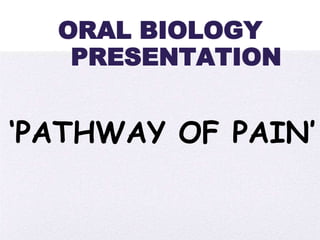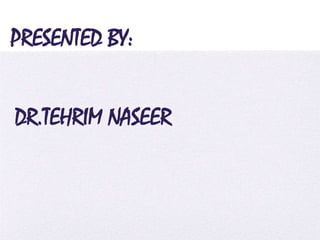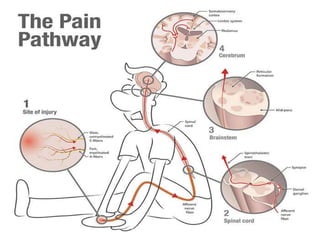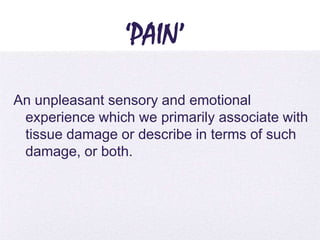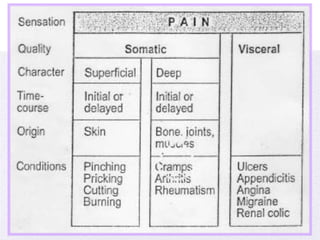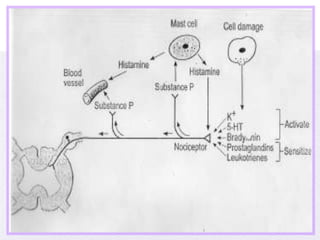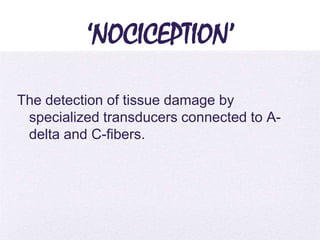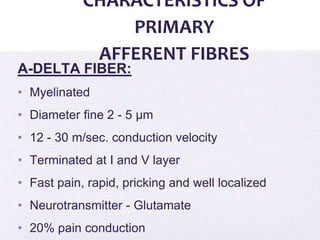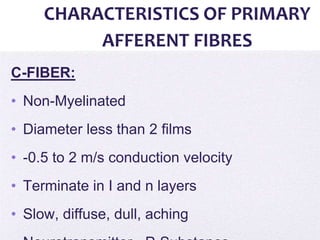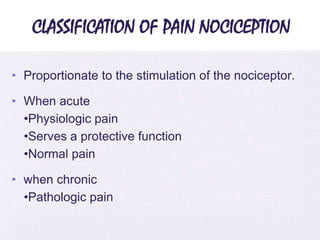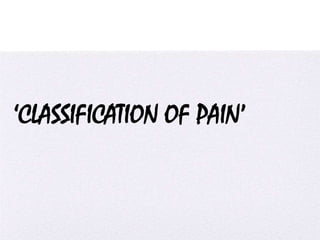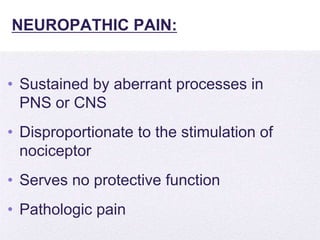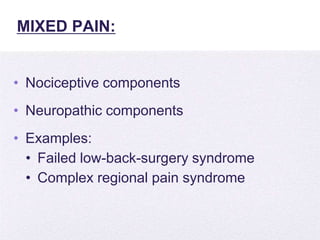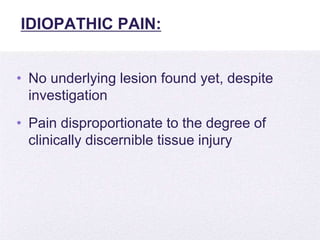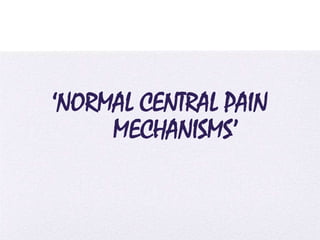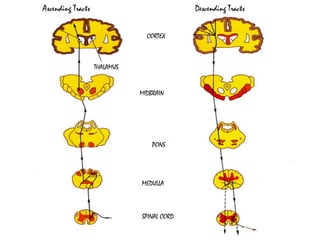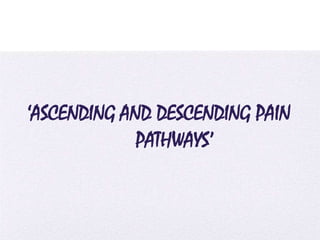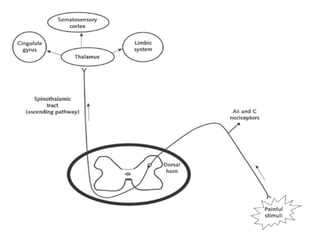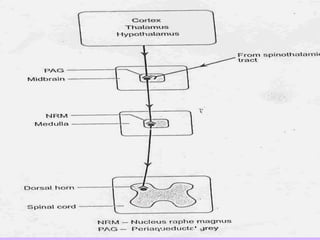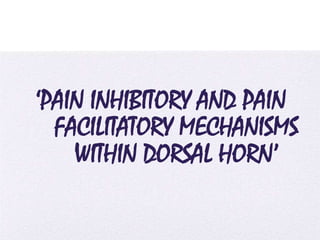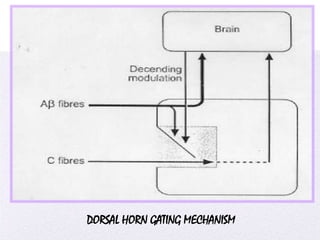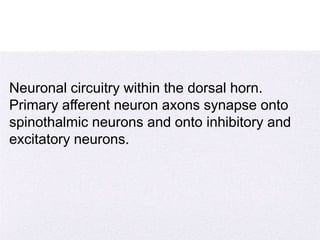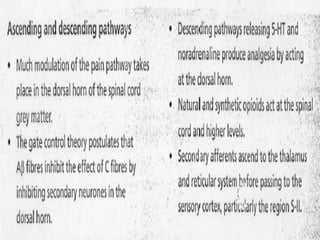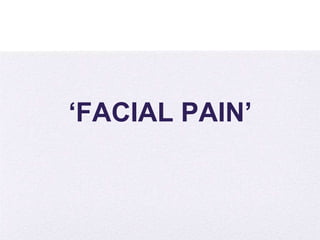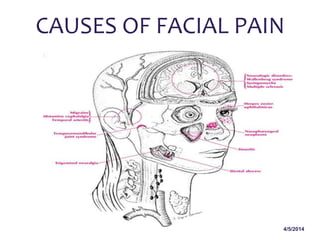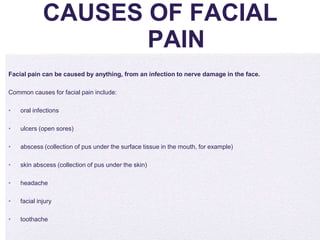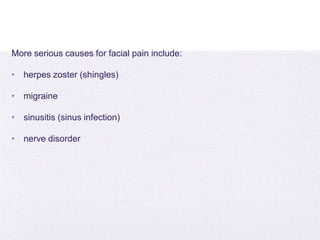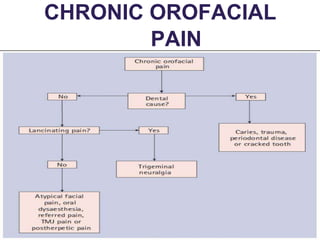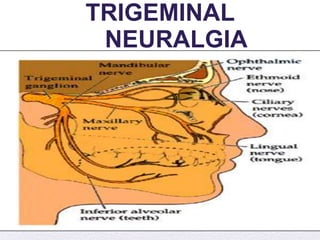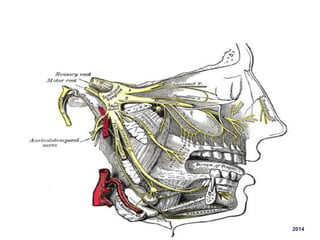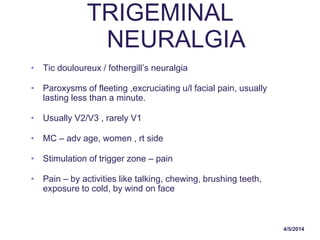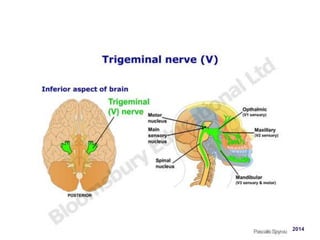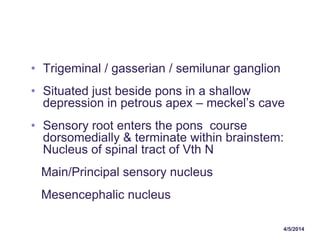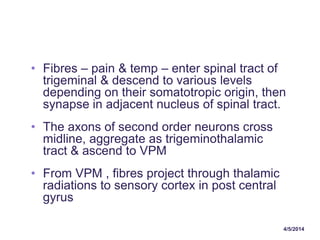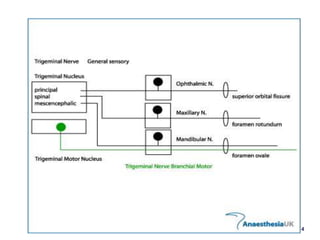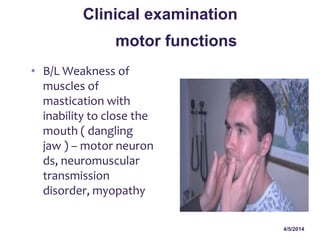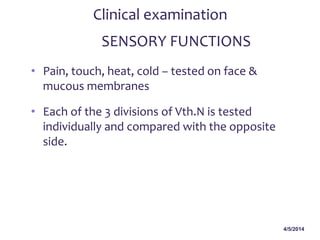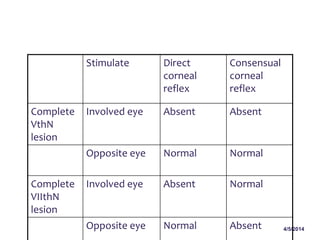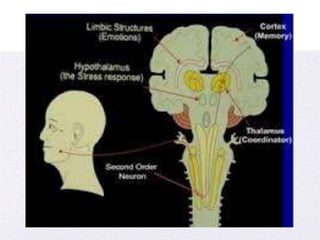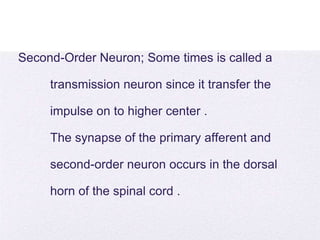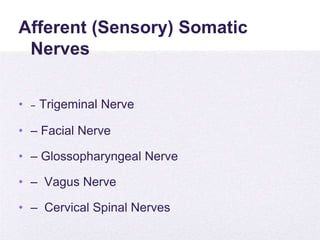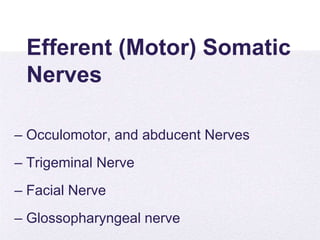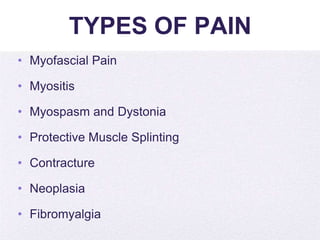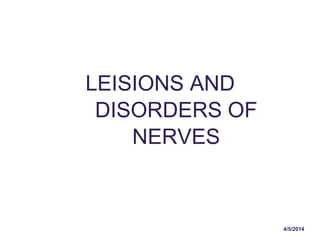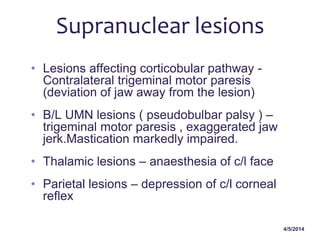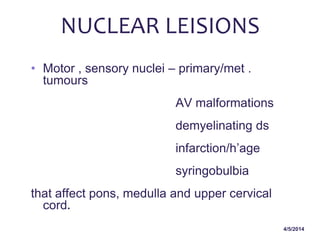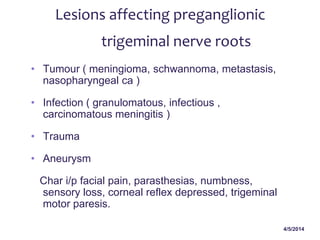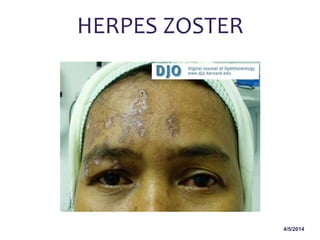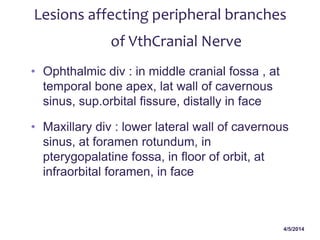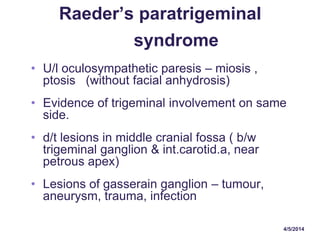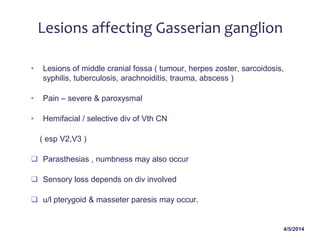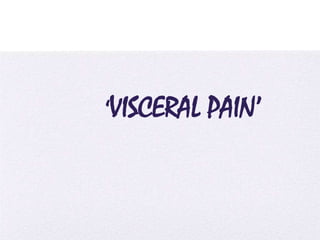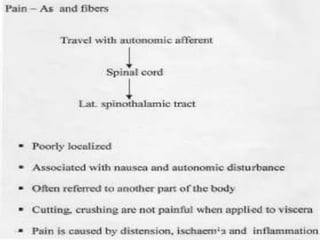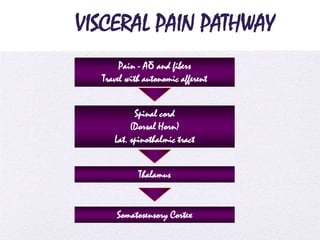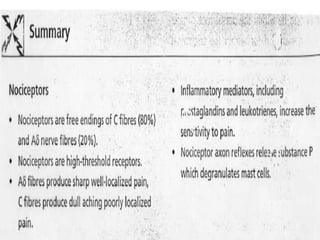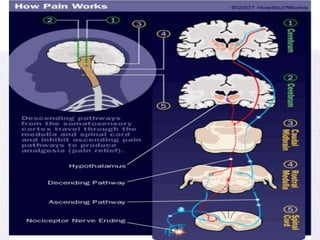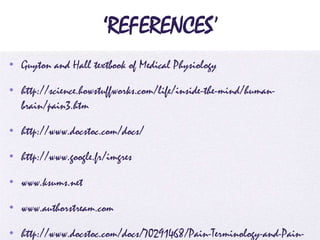Pathway of Pain
- 1. 4/5/2014
- 2. 4/5/2014 ‘PATHWAY OF PAIN’ ORAL BIOLOGY PRESENTATION
- 4. 4/5/2014
- 5. 4/5/2014 ‘PAIN’ An unpleasant sensory and emotional experience which we primarily associate with tissue damage or describe in terms of such damage, or both.
- 6. 4/5/2014
- 7. 4/5/2014
- 8. 4/5/2014 ‘NOCICEPTION’ The detection of tissue damage by specialized transducers connected to A- delta and C-fibers.
- 9. 4/5/2014 CHARACTERISTICS OF PRIMARY AFFERENT FIBRES A-DELTA FIBER: • Myelinated • Diameter fine 2 - 5 μm • 12 - 30 m/sec. conduction velocity • Terminated at I and V layer • Fast pain, rapid, pricking and well localized • Neurotransmitter - Glutamate • 20% pain conduction
- 10. 4/5/2014 CHARACTERISTICS OF PRIMARY AFFERENT FIBRES C-FIBER: • Non-Myelinated • Diameter less than 2 films • -0.5 to 2 m/s conduction velocity • Terminate in I and n layers • Slow, diffuse, dull, aching
- 11. 4/5/2014 CLASSIFICATION OF PAIN NOCICEPTION • Proportionate to the stimulation of the nociceptor. • When acute •Physiologic pain •Serves a protective function •Normal pain • when chronic •Pathologic pain
- 13. 4/5/2014 NEUROPATHIC PAIN: • Sustained by aberrant processes in PNS or CNS • Disproportionate to the stimulation of nociceptor • Serves no protective function • Pathologic pain
- 14. 4/5/2014 MIXED PAIN: • Nociceptive components • Neuropathic components • Examples: • Failed low-back-surgery syndrome • Complex regional pain syndrome
- 15. 4/5/2014 IDIOPATHIC PAIN: • No underlying lesion found yet, despite investigation • Pain disproportionate to the degree of clinically discernible tissue injury
- 17. 4/5/2014 Ascending Tracts Descending Tracts CORTEX MIDBRAIN PONS MEDULLA SPINAL CORD THALAMUS
- 18. 4/5/2014 ‘ASCENDING AND DESCENDING PAIN PATHWAYS’
- 19. 4/5/2014
- 20. 4/5/2014
- 21. 4/5/2014 ‘PAIN INHIBITORY AND PAIN FACILITATORY MECHANISMS WITHIN DORSAL HORN’
- 22. 4/5/2014 DORSAL HORN GATING MECHANISM
- 23. 4/5/2014 Neuronal circuitry within the dorsal horn. Primary afferent neuron axons synapse onto spinothalmic neurons and onto inhibitory and excitatory neurons.
- 24. 4/5/2014
- 26. 4/5/2014 CAUSES OF FACIAL PAIN
- 27. 4/5/2014 CAUSES OF FACIAL PAIN Facial pain can be caused by anything, from an infection to nerve damage in the face. Common causes for facial pain include: • oral infections • ulcers (open sores) • abscess (collection of pus under the surface tissue in the mouth, for example) • skin abscess (collection of pus under the skin) • headache • facial injury • toothache
- 28. 4/5/2014 More serious causes for facial pain include: • herpes zoster (shingles) • migraine • sinusitis (sinus infection) • nerve disorder
- 31. 4/5/2014
- 32. 4/5/2014 TRIGEMINAL NEURALGIA • Tic douloureux / fothergill’s neuralgia • Paroxysms of fleeting ,excruciating u/l facial pain, usually lasting less than a minute. • Usually V2/V3 , rarely V1 • MC – adv age, women , rt side • Stimulation of trigger zone – pain • Pain – by activities like talking, chewing, brushing teeth, exposure to cold, by wind on face
- 33. 4/5/2014
- 34. 4/5/2014 • Trigeminal / gasserian / semilunar ganglion • Situated just beside pons in a shallow depression in petrous apex – meckel’s cave • Sensory root enters the pons course dorsomedially & terminate within brainstem: Nucleus of spinal tract of Vth N Main/Principal sensory nucleus Mesencephalic nucleus
- 35. 4/5/2014 • Fibres – pain & temp – enter spinal tract of trigeminal & descend to various levels depending on their somatotropic origin, then synapse in adjacent nucleus of spinal tract. • The axons of second order neurons cross midline, aggregate as trigeminothalamic tract & ascend to VPM • From VPM , fibres project through thalamic radiations to sensory cortex in post central gyrus
- 36. 4/5/2014
- 37. 4/5/2014 • B/L Weakness of muscles of mastication with inability to close the mouth ( dangling jaw ) – motor neuron ds, neuromuscular transmission disorder, myopathy Clinical examination motor functions
- 38. 4/5/2014 Clinical examination SENSORY FUNCTIONS • Pain, touch, heat, cold – tested on face & mucous membranes • Each of the 3 divisions of Vth.N is tested individually and compared with the opposite side.
- 39. 4/5/2014 Stimulate Direct corneal reflex Consensual corneal reflex Complete VthN lesion Involved eye Absent Absent Opposite eye Normal Normal Complete VIIthN lesion Involved eye Absent Normal Opposite eye Normal Absent
- 40. 4/5/2014
- 41. 4/5/2014 Second-Order Neuron; Some times is called a transmission neuron since it transfer the impulse on to higher center . The synapse of the primary afferent and second-order neuron occurs in the dorsal horn of the spinal cord .
- 42. 4/5/2014 Afferent (Sensory) Somatic Nerves • – Trigeminal Nerve • – Facial Nerve • – Glossopharyngeal Nerve • – Vagus Nerve • – Cervical Spinal Nerves
- 43. 4/5/2014 Efferent (Motor) Somatic Nerves – Occulomotor, and abducent Nerves – Trigeminal Nerve – Facial Nerve – Glossopharyngeal nerve
- 44. 4/5/2014 TYPES OF PAIN • Myofascial Pain • Myositis • Myospasm and Dystonia • Protective Muscle Splinting • Contracture • Neoplasia • Fibromyalgia
- 46. 4/5/2014 Supranuclear lesions • Lesions affecting corticobular pathway - Contralateral trigeminal motor paresis (deviation of jaw away from the lesion) • B/L UMN lesions ( pseudobulbar palsy ) – trigeminal motor paresis , exaggerated jaw jerk.Mastication markedly impaired. • Thalamic lesions – anaesthesia of c/l face • Parietal lesions – depression of c/l corneal reflex
- 47. 4/5/2014 NUCLEAR LEISIONS • Motor , sensory nuclei – primary/met . tumours AV malformations demyelinating ds infarction/h’age syringobulbia that affect pons, medulla and upper cervical cord.
- 48. 4/5/2014 Lesions affecting preganglionic trigeminal nerve roots • Tumour ( meningioma, schwannoma, metastasis, nasopharyngeal ca ) • Infection ( granulomatous, infectious , carcinomatous meningitis ) • Trauma • Aneurysm Char i/p facial pain, parasthesias, numbness, sensory loss, corneal reflex depressed, trigeminal motor paresis.
- 50. 4/5/2014 Lesions affecting peripheral branches of VthCranial Nerve • Ophthalmic div : in middle cranial fossa , at temporal bone apex, lat wall of cavernous sinus, sup.orbital fissure, distally in face • Maxillary div : lower lateral wall of cavernous sinus, at foramen rotundum, in pterygopalatine fossa, in floor of orbit, at infraorbital foramen, in face
- 51. 4/5/2014 Raeder’s paratrigeminal syndrome • U/l oculosympathetic paresis – miosis , ptosis (without facial anhydrosis) • Evidence of trigeminal involvement on same side. • d/t lesions in middle cranial fossa ( b/w trigeminal ganglion & int.carotid.a, near petrous apex) • Lesions of gasserain ganglion – tumour, aneurysm, trauma, infection
- 52. 4/5/2014 Lesions affecting Gasserian ganglion • Lesions of middle cranial fossa ( tumour, herpes zoster, sarcoidosis, syphilis, tuberculosis, arachnoiditis, trauma, abscess ) • Pain – severe & paroxysmal • Hemifacial / selective div of Vth CN ( esp V2,V3 ) Parasthesias , numbness may also occur Sensory loss depends on div involved u/l pterygoid & masseter paresis may occur.
- 54. 4/5/2014
- 55. 4/5/2014 VISCERAL PAIN PATHWAY Pain - Aδ and fibers Travel with autonomic afferent Spinal cord (Dorsal Horn) Lat. spinothalmic tract Thalamus Somatosensory Cortex
- 56. 4/5/2014
- 57. 4/5/2014
- 58. 4/5/2014 ‘REFERENCES’ • Guyton and Hall textbook of Medical Physiology • http://science.howstuffworks.com/life/inside-the-mind/human- brain/pain3.htm • http://www.docstoc.com/docs/ • http://www.google.fr/imgres • www.ksums.net • www.authorstream.com • http://www.docstoc.com/docs/70291468/Pain-Terminology-and-Pain-
- 59. 4/5/2014
- 60. 4/5/2014


